Volume pedals are amongst the most essential components of a musician’s signal chain. However, due to their subtle and understated nature, they are often overlooked in favor of effects that produce more prominent, tone-altering results.
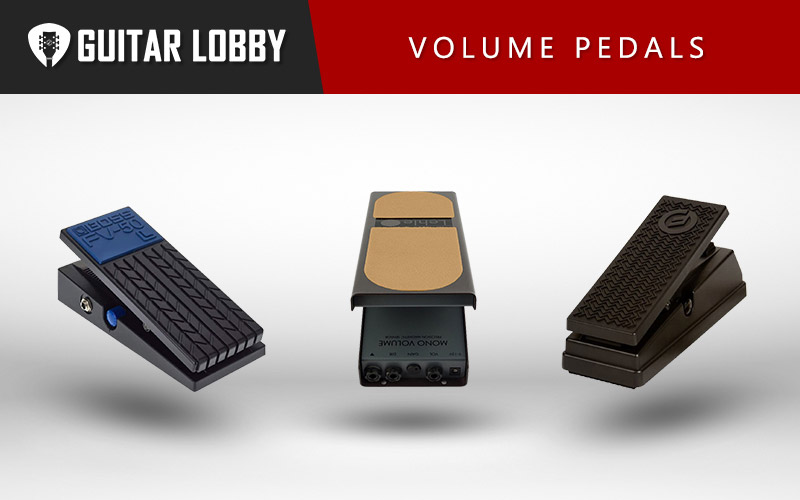
Choosing a good quality volume pedal allows the rest of your effects to operate to their fullest potential. It provides you with absolute control over your dynamics and allows you to keep a level of consistency throughout your pedalboard.
Over the years our team at Guitar Lobby has tested dozens of these pedals, and in this article, we’ll be discussing the best volume pedals at each price point. Many variations are tailor-made for specific styles and purposes, so no matter what your requirements are, you’ll find the perfect option.
| Name of Product | Image of Product | Description | Price Range | Full Review |
|---|---|---|---|---|
| 1. Lehle Mono Volume Pedal (Best Overall) | 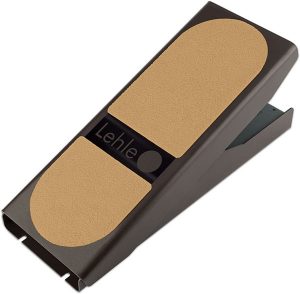 | Type: Analog Effects: Volume | $300 | Read Full Review Below |
| 2. Ernie Ball MVP (Best Value) | 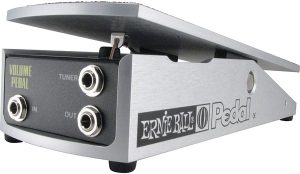 | Type: Analog Effects: Volume | $110 | Read Full Review Below |
| 3. BOSS FV-50L (Best Under $100) | 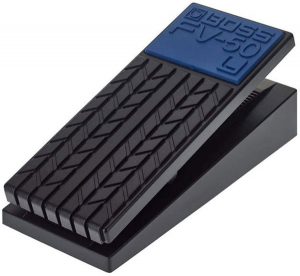 | Type: Analog Effects: Volume | $100 | Read Full Review Below |
| 4. Ernie Ball VP Jr (Best Under $75) | 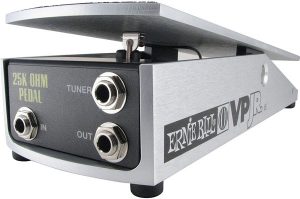 | Type: Analog Effects: Volume | $70 | Read Full Review Below |
| 5. Sonicake VolWah (Best Under $60) | 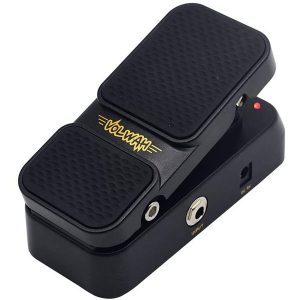 | Type: Analog Effects: Volume | $60 | Read Full Review Below |
| 6. Moog EP-3 (Best Under $50) | 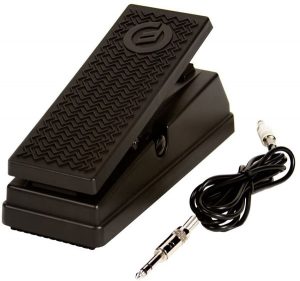 | Type: Analog Effects: Volume | $50 | Read Full Review Below |
| 7. MeloAudio EXP-001 | 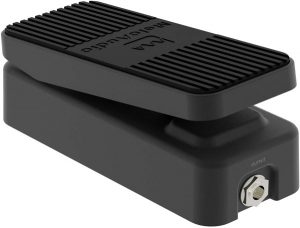 | Type: Analog Effects: Volume | $70 | Read Full Review Below |
| 8. JOYO Multimode | 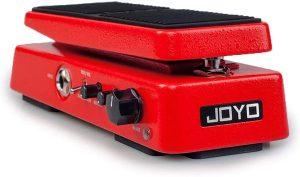 | Type: Analog Effects: Volume | $80 | Read Full Review Below |
| 9. M-Audio EX-P | 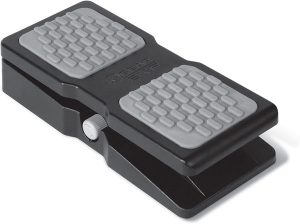 | Type: Analog Effects: Volume | $30 | Read Full Review Below |
| 10. BOSS FV-500H | 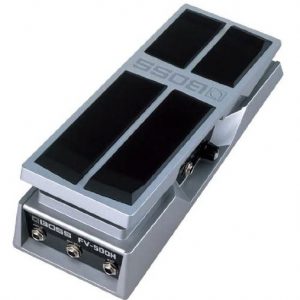 | Type: Analog Effects: Volume | $115 | Read Full Review Below |
| 11. Dunlop DVP4 (Great for Swells) | 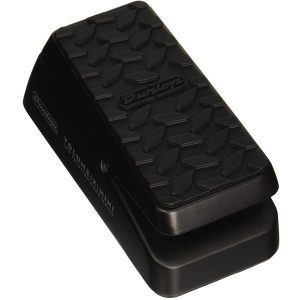 | Type: Analog Effects: Volume | $120 | Read Full Review Below |
| 12. BOSS FV-30H | 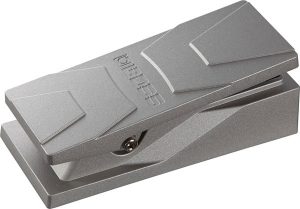 | Type: Analog Effects: Volume | $100 | Read Full Review Below |
| 13. Mission Engineering Helix | 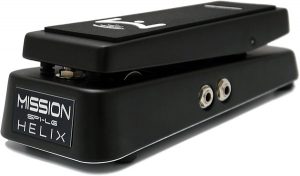 | Type: Analog Effects: Volume | $150 | Read Full Review Below |
| 14. Fender EXP-1 | 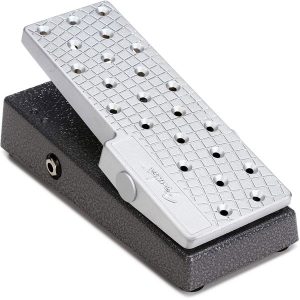 | Type: Digital Effects: Volume | $90 | Read Full Review Below |
| 15. Ernie Ball Black VP jr | 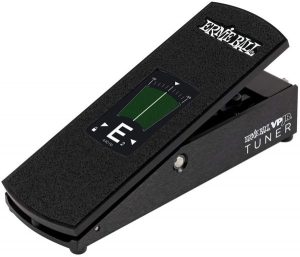 | Type: Digital Effects: Volume | $200 | Read Full Review Below |
| 16. BOSS FV-500L | 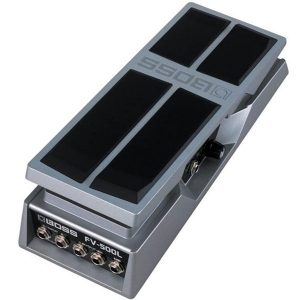 | Type: Analog Effects: Volume | $120 | Read Full Review Below |
| 17. Line 6 EX-1 | 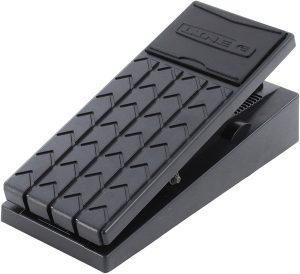 | Type: Analog Effects: Volume | $60 | Read Full Review Below |
Here Are the Best Volume Guitar Pedals
1. Lehle Mono Volume Pedal (Best Overall)
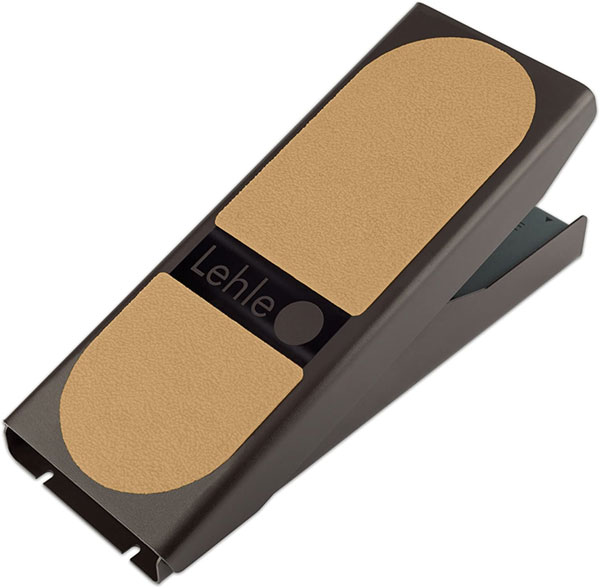
| Estimated Price | $300 |
| Type | Analog |
| Effects | Volume |
| Connectivity | 1 x 6.35mm Jack Input, 1 x Output |
| Power | 9 Volts DC |
My Review: I was initially excited to try this Lehle device, and it didn’t disappoint. With a precise magnetic sensor, inner components of the highest quality, and a sleek design, it soon became clear to me that the Mono Volume by Lehle is one of the finest pedals for controlling dynamics. It can operate in a noise-free, reliable way due largely to the meticulous design of its circuitry. I learned that when designing the pedal, Lehle chose to utilize a method known as the Hall effect to get the most accurate results.
The Hall method is used to track the strength of the magnetic fields, and a sensor, which is calibrated to the inbuilt magnet is used to control the dynamic range produced by the pedal. I’m aware that this may sound complex, but when testing it out, my experience operating the Mono Volume Pedal couldn’t be more straightforward.
In comparison to most other volume pedals, this Lehle device provides much more accurate control over dynamics. The voltage-controlled amplifier works based on the variations in gain, which are caused by the voltage received by the Hall sensor. In the process, any operational noise is eliminated, and the signal integrity is perfectly preserved. This allowed me to quickly adjust the volume of the guitar signal, thus improving the performance of the other pedals in my signal chain.
Another thing that impressed me about this pedal is its capability of achieving a dynamic range of 100 dB, with the volume ranging from completely muted to an additional +1- dB of gain. In terms of the mechanics of this Lehle device, it has low-friction grip bearings and there is an adjustable screw that I used to tailor the mobility to suit my liking.
Who is this best suited for: If you require the maximum control over the volume of your instrument, then I’d highly recommend the Lehle Mono Volume Pedal. It has been designed using sophisticated inner mechanisms that combine to create a perfect blend of smooth operation, precise control, and noise elimination.
Bottom Line: Indeed, a basic volume pedal may be adequate if you simply want a level of control of your instrument’s dynamics. However, if you require a precision of the highest order, the Lehle Mono Volume Pedal offers this in abundance. It operates silently, with no risk of electronic noise emerging in your output. The Hall sensor, which works with a magnetic field, ensures that the pedal produces a high standard of audio quality and impressive responsiveness across the dynamic range.
2. Ernie Ball MVP (Best Value)
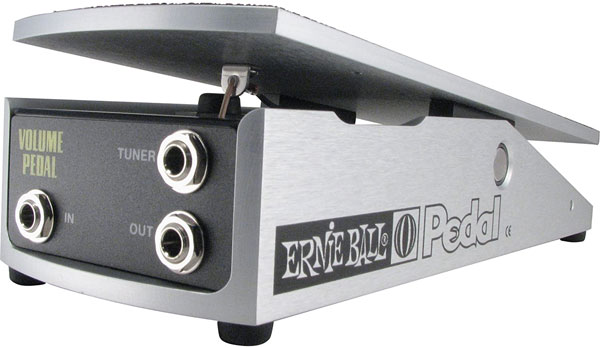
| Estimated Price | $110 |
| Type | Analog |
| Effects | Volume |
| Connectivity | 2 x 6.35mm Jack Input, 1 x Output |
| Power | 9 Volts DC |
My Review: After testing the Most Valuable Pedal by Ernie Ball, I can safely say that it is amongst the best volume and expression offerings available. With its stylish design, high-quality build materials, and exceptionally smooth operation, I found this pedal to be truly a joy to use.
One of the first things that I noticed about this pedal, is that it provides a super-smooth foot sweep. This feature allowed me to focus on my playing without worrying about over-adjusting the rocker plate. For that reason, the MVP is perfectly suited to precisely controlling the volume of a guitar.
From past experience, I’ve found that a common issue with volume pedals is the high-end frequency loss that can occur, but I was pleased to discover that Ernie Ball has ensured that this is not the case with the MVP. It is compatible with both passive and active electronics, which is an added bonus.
There are several qualities that set the MVP apart from other volume pedals. Firstly, it generously allows the audio signal to be increased up to +20 decibels, which affords exceptional freedom and control over the dynamics. Also, I’d go as far as to say this pedal is basically indestructible thanks to its robust build quality.
Who is this best suited for: Guitarists who are looking for the best possible way to control the volume of their instrument should strongly consider the MVP by Ernie Ball. It’s a highly versatile pedal that works with all types of electronics.
Bottom Line: With unrivaled smoothness, pin-point precision and a guarantee of high-frequency preservation, the MVP by Ernie Ball is a truly brilliant volume pedal. It’s constructed from aircraft-grade aluminum and can be powered using either a 9v DC battery or external power supply. It also offers minimum volume control and a gain booster, which is capable of raising your level by up to +20dB.
3. BOSS FV-50L (Best Under $100)
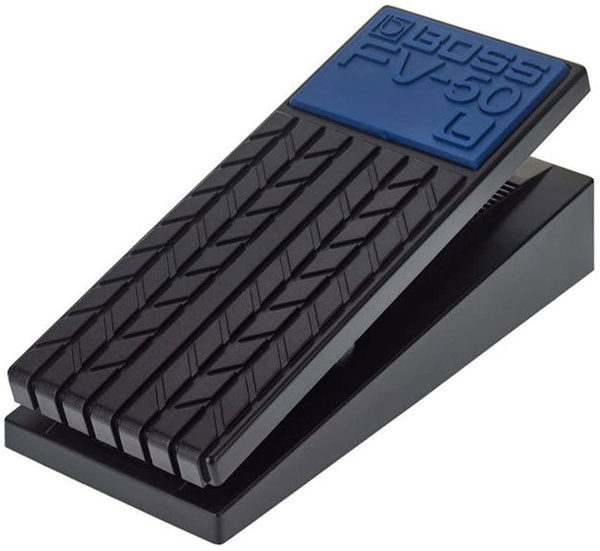
| Estimated Price | $100 |
| Type | Analog |
| Effects | Volume |
| Connectivity | 2 x 6.35mm Jack Input, 2 x Outputs |
| Power | 9 Volt |
My Review: The FV-50L by Boss is a great value volume pedal that has all of the necessary capabilities required to act as the central hub for your dynamics. It’s equally suited to a keyboard, guitar, bass or synth, and features a solid built with a responsive rocker plate so that you can adjust the volume accurately.
A low-impedance pedal, the FV-50L is highly compatible with stereo effects units and keyboards. It includes singular minimum volume control, which can be used to set the baseline dynamic level to ensure that no sudden spikes occur.
With a pair of inputs and outputs, you can use the FV-50L for several connectivity options. There’s a specially designed tuner-output, which allows you to link the pedal to your tuner for instant and responsive performance. The pedal also has grip-grooves to create the perfect amount of friction between you and the rocker plate.
The FV-50L is likely to be very useful in situations when quick adjustment of an instrument’s volume is required. Speed isn’t all that this pedal offers, though. It’s also incredibly accurate, which makes it possible to be very precise when setting the level of a guitar, bass, or keyboard. Compared to similarly-priced pedals, its smooth functionality sets it apart.
Who is this best suited for: Guitarists, keyboardists, bassists, or synth players who require a responsive volume pedal that is easy to set up and operate will love the Boss FV-50L. It provides the ideal blend of control and easy usage, without overcomplicating things with unnecessary parameters.
Bottom Line: As with all Boss effects pedals, the FV-50L is solidly built and performs at a reliably high standard. With a solid, responsive rocker plate, numerous inputs and output connections, and minimum volume control, this pedal is great value for money. Overall, I’d say the BOSS FV-50L is the best volume pedal under $100.
4. Ernie Ball VP Jr (Best Under $75)
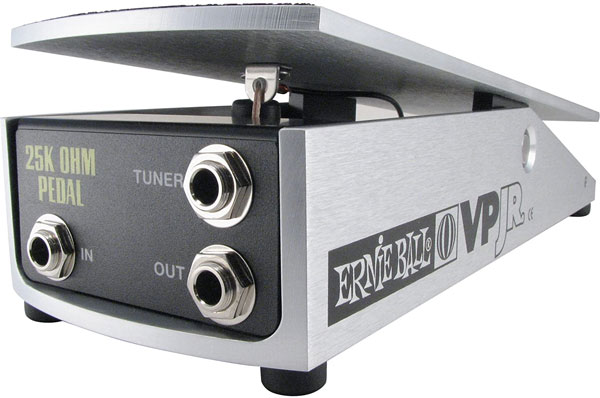
| Estimated Price | $70 |
| Type | Analog |
| Effects | Volume |
| Connectivity | 1 x 6.35mm Jack Input, 2 x Output |
| Power | 9 Volts DC |
My Review: Here at Guitar Lobby, we’re huge fans of Ernie Ball. Perhaps best known for their top-of-the-range selection of guitar and bass strings, they also have a great deal of expertise when it comes to effects pedals. I believe that this is most prominently reflected in their range of volume and expression pedals, which is amongst the most extensive of any manufacturer.
When I first got my hands on the VP Jr, I was impressed to find that it boasts a 250k ohm resistance, making it ideally suited for use with passive instruments such as electric guitars, basses, and keyboards. This allowed me to use it as a utility pedal, rather than solely for guitar. Situated just behind the jack input, there is a useful micro taper switch which I used to create two different volume swell rates.
In the past, I’ve found that creating swells using a volume pedal is a great way to generate ambient textures within a song. Ernie Ball VP Jr is great for this purpose. It has a solidly built pivot shaft that is made from stainless steel and precisely secured using nylon bushings. This solid mechanism is joined by stainless steel springs for ultimate durability.
One of the scenarios that I believe the VP Jr is most useful, is when creating textural swells to add ambient sounds to your output. The pedal has evolved from the popular VP series, and Ernie Ball has managed to condense all of the best features of previous models into a smaller housing for added convenience.
Who is this best suited for: If you’re looking for a min-sized volume pedal that is capable of withstanding consistently heavy usage, look no further than the Ernie Ball VP Jr. It’s an ideal choice for guitarists who are constantly on the road or rehearsing in the practice room.
Bottom Line: Ernie Ball’s reputation amongst guitarists and bassists is almost unrivaled, due to the care and thought that goes into all of their products. The VP Jr reinforces that notion, with a combination of solid, high-quality metals used to compose the volume pedal and inner electronic components of the highest order. This is hands down one of the best mini volume pedals out there and for the price, it’s nearly impossible to beat.
5. Sonicake VolWah (Best Under $60)
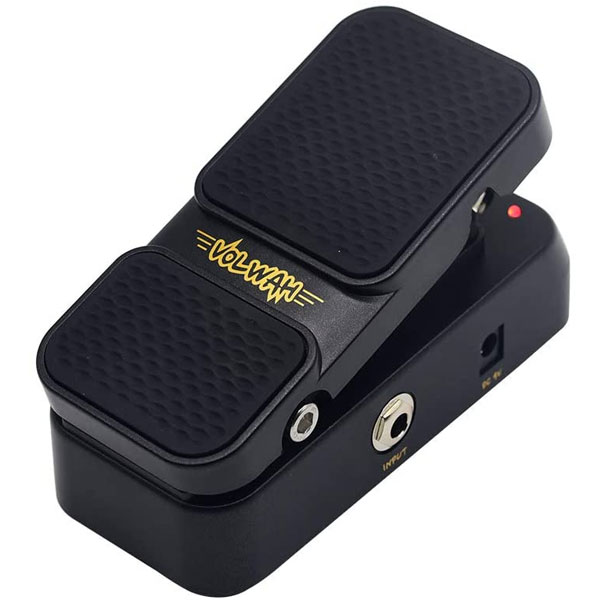
| Estimated Price | $60 |
| Type | Analog |
| Effects | Volume |
| Connectivity | 1 x 6.35mm Jack Input, 1 x Output |
| Power | 9 Volts DC |
My Review: I’ve long been an admirer of how Sonicake’s range of affordable effects pedals has earned them the trust of guitarists, bassists, and keyboardists across all genres and styles. My findings showed me that the VolWah is an exceptional volume pedal, and I was particularly impressed by its compactly-sized and ability to withstand the rigors of being a touring musician.
As a lover of vintage-style technology, one thing that I was particularly excited about was the fact that this pedal is completely analog and doubles up as a Wah pedal. I enjoyed the lightweight of the housing and found it to be also robust. Right off the bat, I could tell that the useful active volume control minimizes the risk of impedance issues caused by dynamic inconsistencies.
The wah sound it produces resembles the classic Crybaby, and by simply clicking the hidden footswitch I was able to use the pedal as a reliable volume controller. This two-dimensional functionality is what, in my opinion, separates this pedal from similarly priced devices. It removes the need for purchasing a separate wah pedal, which an additional bonus!
Who is this best suited for: The Sonicake VolWah combine dynamic control with wah-wah, and is, therefore, a perfect match for guitarists who want to add both effects to their pedalboard. It is a fairly small pedal, and therefore well suited to those who perhaps are limited for space in their signal chain.
Bottom Line: Volume and wah pedals operate using the same rocker-plate mechanism, so it makes perfect sense to combine the two in a smartly designed format. The Volwah by Sonicake allows you to switch between the two modes using a discreet footswitch, and a pair of LEDs indicate which effect is selected at any time.
6. Moog EP-3 (Best Under $50)
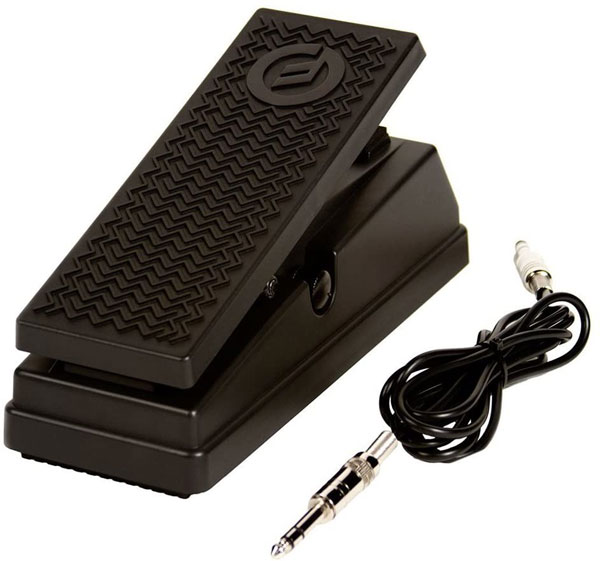
| Estimated Price | $50 |
| Type | Analog |
| Effects | Volume |
| Connectivity | 1 x 6.35mm Jack Input, 1 x Output |
| Power | 9 Volts DC |
My Review: Moog is a legendary manufacturer of synthesizers and electronic music devices, so it was no surprise for me to discover that they also produce a unique, innovative volume pedal. One of the things that instantly sold me on the EP-3 is its durability – it’s built like a tank and afforded me with the option of either controlling my whole dynamic output or dedicating the pedal to a specific parameter on another effect.
If I had to identify the main contributor to the quality of the Moog EP3, I’d say that it is its smooth action. The pedal is responsive but provided enough resistance so that I could be bold when adjusting the rocker plate to achieve my desired effect.
Another bonus feature I discovered is that it also has a polarity switch to ensure its compatibility with any inputs that are specifically for expression or volume pedals. My findings led me to the conclusion that the EP-3 is ideal for being used with pedals, or devices like synthesizers, which are notoriously difficult to tame due to their complex outputs.
Who is this best suited for: I’d highly recommend the Moog EP3 to musicians who value smooth operation. Despite its lack of onboard controls, this volume and expression pedal compensates by offering flawless performance and impressive durability.
Bottom Line: Although the Moog EP3 isn’t littered with additional parameters, it performs two simple functions very effectively. Firstly, you can simply use it as a volume pedal to oversee the dynamic output of your instrument. Alternatively, you can connect it to the expression input of another pedal or amplifier, and use it to adjust the characteristics of your tone. In my opinion, this is the best volume guitar pedal under $50.
7. MeloAudio EXP-001
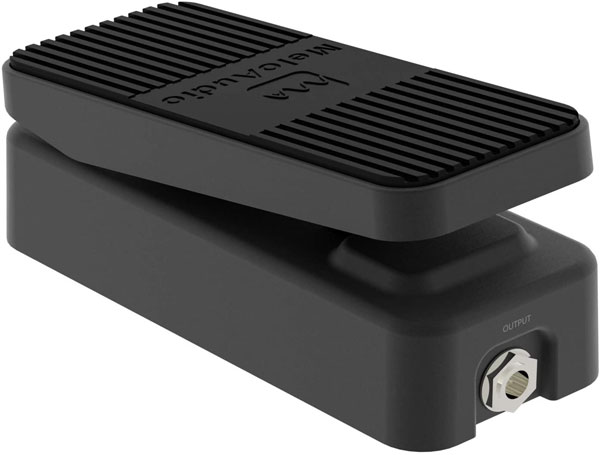
| Estimated Price | $70 |
| Type | Analog |
| Effects | Volume |
| Connectivity | 1 x 6.35mm Jack Input, 1 x Output |
| Power | 9 Volts DC |
My Review: If you’re a multi-instrumentalist, I think you’ll enjoy the EXP-001 by MeloAudio. It soon became clear to me that this device offers ultra-smooth pedal movement so that I could use it to comfortably control the volume of my guitar, bass, or keyboard. It also doubles up as a capable expression pedal and has a small, compact sizing which in my experience makes it a convenient addition to any signal chain.
With a pedal shaft that has a dampening mechanism, one thing I noticed about the EXP-001 is that it can retain a specific angle and not move unless contact is made. This afforded me the peace of mind required to focus solely on playing technique. It is housed in a durable cast aluminum housing, and the rocker is made from rubber to ensure the utmost grip and stability.
If I was to identify the main quality which makes this volume pedal stand out amongst the crowd, it would have to be its impeccable non-slip action. The last thing a musician needs is for their foot to slip off the volume pedal at the pivotal moment, so the design of the EXP-001 was music to my ears!
Who is this best suited for: I’d recommend the EXP-001 to any musicians who are looking for a compact pedal to control either their dynamics or the expression of other effects. It is conveniently compact, so even if your pedalboard is a little on the crowded side, you can still easily find room for this MeloAudio volume controller.
Bottom Line: With smooth pedal motion, and enough resistance to stay in its intended position, the MeloAudio EXP-001 is an excellent expression and volume pedal. It can be used to precisely set the volume level of your chosen instrument, or connected to the expression input of another pedal to adjust a certain parameter housed on that effect.
8. JOYO Multimode
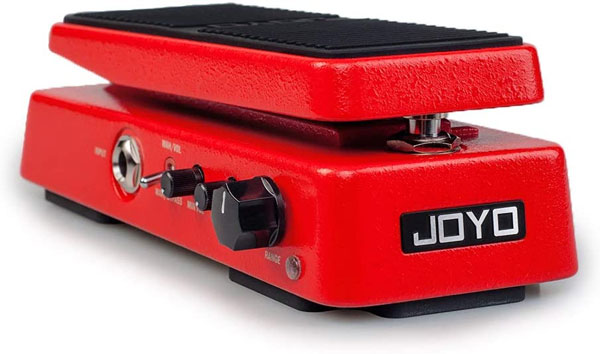
| Estimated Price | $80 |
| Type | Analog |
| Effects | Volume |
| Connectivity | 1 x 6.35mm Jack Input, 1 x Output |
| Power | 9 Volts DC |
My Review: In recent years, we’ve witnessed JOYO’s emergence as one of the leading providers of affordable effects pedals. I’m a huge admirer of their extensive range, which spans across distortion, modulation, and reverbs, and with the Multimode pedal, I was pleased to learn that they have ventured into the world of volume and wah.
Compared to other combination units, the Multimode allows you to quickly switch between the functions of a conventional volume pedal and a wah-style filter pedal. A particular aspect that I think could be very useful is that this pedal has a fitted bypass toggle switch and a total of 6 onboard wah frequency ranges.
I was also really impressed with the volume mode, which comes with a Q control to tailor the settings of your levels, and the LED indicators clearly signify which mode I had selected.
What makes this pedal stand out is undoubtedly its ability to act both as a solid, reliable volume controller and a wah-wah device. Not only does this save space in the signal chain, but it is also useful for quickly switching between high-energy tones and more controlled dynamic outputs.
Who is this best suited for: The JOYO Multimode Wah/Volume pedal is a great choice for guitarists who need to save space on their pedalboard. It functions to a high level as both a standard volume controller or a wah filter pedal, so if both of these effects are on your wishlist, you can save time and effort with this JOYO offering.
Bottom Line: With instant switching between volume and wah mode, the JOYO Multimode pedal performs smoothly and reliably. It features Q controls for both modes and several selectable frequency ranges which adjust the characteristics of the onboard wah effect.
9. M-Audio EX-P
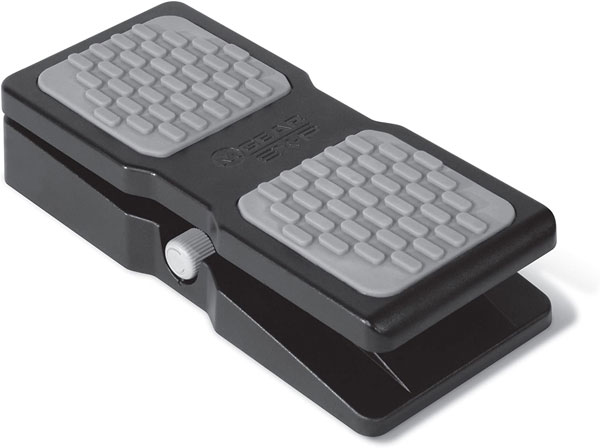
| Estimated Price | $30 |
| Type | Analog |
| Effects | Volume |
| Connectivity | 1 x 6.35mm Jack Input, 1 x Output |
| Power | 9 Volts DC |
My Review: Upon analysis, I found the affordable, easy to use, and versatile EX-P by M-Audio to be a great volume and expression pedal. I was instantly drawn to the standout quality of the pedal, which is its compatibility with MIDI. I already knew that M-Audio is renowned for its brilliant line of MIDI controllers, and was pleased to find that they have used this expertise to design a compatible pedal.
With an onboard polarity switch, what sold me on the EX-P is that it can work with any MIDI controller, instrument, or separate effects pedal, regardless of voltage differences. I found it simple to assign the pedal to any parameter on a MIDI controller, and use it to adjust the modulation, panning, filter sweep, or of course, the volume level.
This expression and volume pedal features a grip-teeth design which I found prevented my foot from slip off when using it. This feature allowed me to focus my attention on playing the instrument rather than worrying about foot positioning. It is built from a combination of durable metal, rubber, and high-strength plastic, so I’m confident that it can withstand heavy usage.
My experience using the EX-P led me to the summary that it’s the best MIDI-focused volume/expression device on the market. It stands out due to its compatibility with keyboards, synths, drum machines, and other MIDI-based instruments or controllers.
Who is this best suited for: If you use MIDI controllers and keyboards onstage, or digital effects pedals with various adjustable parameters, the EX-P by M-Audio is a great choice. Compared to other high-end volume pedals, it’s pretty low-priced, so for those shopping on a tight budget, I’d recommend considering it.
Bottom Line: Although the EX-P performs at its best when used in conjunction with an M-Audio MIDI controller, it has an inbuilt polarity switch to ensure that it’s also compatible with other devices. You can simply use it to control volume conventionally, or hook it up to another pedal or MIDI instrument of your choice and use it to alter your effects in real-time.
10. BOSS FV-500H
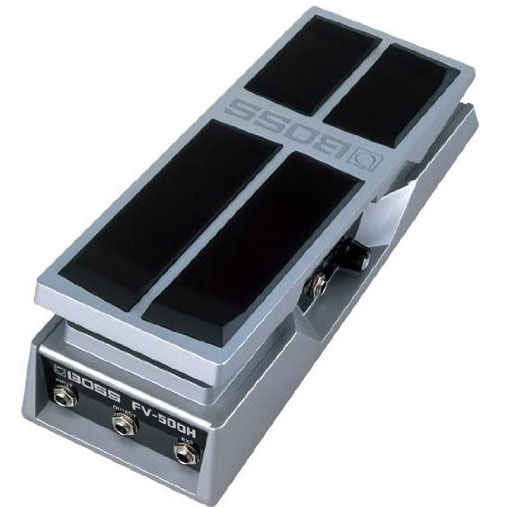
| Estimated Price | $115 |
| Type | Analog |
| Effects | Volume |
| Connectivity | 2 x 6.35mm Jack Input, 2 x Output |
| Power | 9 Volts DC |
My Review: When I think of Boss pedals, the first quality that springs to mind is durability. Their comprehensive range of stompbox effects is, in my experience, amongst the most solidly built on the market. I’d go as far as to say that attribute is one of the most important qualities when discussing volume pedals.
The FV-500H is an improved version of the classic FV-300 that has been so popular amongst guitarists for over a decade. Compared to the FV-300, I liked that this product has an improved rocker plate mechanism and includes additional parameters. A high-impedance volume pedal, the FV-500H is housed in a stylish, metal chassis, and boasts smooth and responsive action.
The coating of the pedal is made from rubber, which I like because it promotes grip and stability. It took a little while to get the hang of the fact that I could adjust the torque of the pedal, which is useful if you find it to be too stiff or loose, and surprisingly I found that it also doubles up as a capable expression pedal for controlling the various elements of my other effects. There’s also a convenient tuner-output jack which makes quick and easy tuning possible.
The standout quality of the FV-500H is versatility. It raises the bar of BOSS’ highly respected line of volume pedals, which is some achievement when you consider how good the previous FV300 range was. It’s also ideal for being used with high-impedance devices, which is a refreshing improvement.
Who is this best suited for: Like all Boss pedals, the FV-500H is built to stand the test of time. Its heavy-duty aluminum dies cast chassis, combined with a non-slip rubber pedal, make it a great choice for guitarists who are likely to use their volume pedal very often.
Bottom Line: The FV-500H by Boss offers the best of both worlds. You can use it as an expression pedal for controlling external effects, or simply set it up as a conventional volume pedal to manage your dynamics. It operates very smoothly thanks to the high-quality build techniques used by the manufacturer, and you can even tweak the resistance of the pedal to suit your individual preferences.
11. Dunlop DVP4 (Best for Swells)
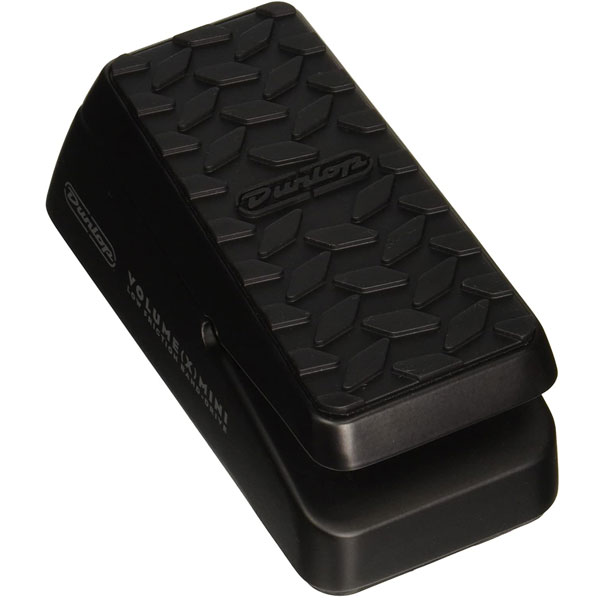
| Estimated Price | $120 |
| Type | Analog |
| Effects | Volume |
| Connectivity | 2 x 6.35mm Jack Input, 1 x Output |
| Power | 9 Volts DC |
My Review: Knowing that Dunlop is amongst a rare, small group of effects pedal manufacturers that have been at the forefront throughout the history of rock n’ roll, I was expecting big things from this pedal. Personally, I believe that a strong indicator of their exceptional expertise is the fact that to this day they continue to innovate and inspire musicians worldwide.
The DVP4 is a mini-sized volume pedal, that provides us with absolute control over the dynamic output of our chosen instrument. Like its predecessor the DVP3, I noticed that it boasts commendable durability and operates smoothly thanks to the high-quality rocker mechanism. Compared to the DVP3, I enjoyed the additional grip on the face of the pedal, and its increased connectivity.
Another thing that stood out to me about his Dunlop volume pedal is that it also offers a useful AUX jack that can be used to hook it up to a tuner pedal, or an external effects pedal to be used as an expression device. I found it quite remarkable that such a small volume pedal can offer the level of control that the DVP4 is capable of.
What exactly is it that makes the DVP4 different from most other volume pedals on the market? Well, for starters, I believe the low-friction band-drive has something to do with it. Smoothness is present in abundance with this pedal, which makes it ideal for gradually adjusting the volume of a guitar,bass, or other instruments.
Who is this best suited for: If your pedalboard is looking a little overcrowded and you need a volume pedal that will slot into a tight space, the DVP4 by legendary manufacturers Dunlop is a great option to consider.
Bottom Line: Capable of acting as an expression or volume pedal, the robust DVP4 is a high-quality offering from Dunlop. It has a dedicated AUX output and is half the size of the previous model. Additionally, the DVP4 is surprisingly lightweight despite its durability and solid build. I’d say this is the best volume pedal for swells.
12. BOSS FV-30H
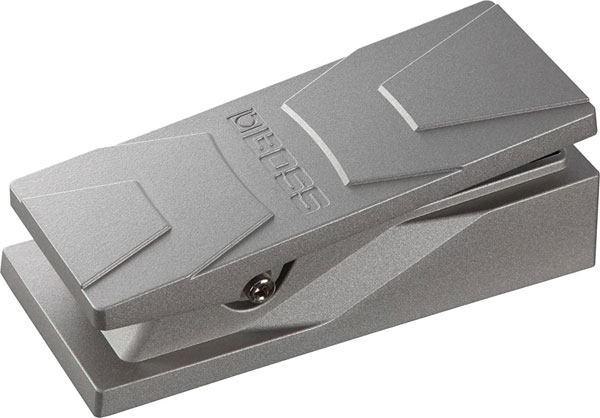
| Estimated Price | $100 |
| Type | Analog |
| Effects | Volume |
| Connectivity | 2 x 6.35mm Jack Input, 1 x Output |
| Power | 9 Volts DC |
My Review: I’m always on the lookout for a high impedance volume pedal specifically for guitar, and therefore I was excited to discover this FV-30H, another top-tier offering from pedal-producing legends, Boss. One of the first things that stood out about it, was the compact and convenient size, which allows us to slot it onto a busy pedalboard easily.
The pedal offers a dedicated tuner output, which also presents the possibility of using it as an expression controller. I was really impressed with this feature, as it is the perfect tool for adding a little boost in volume to my guitar or rolling off the dynamics to conclude a performance.
I also found that the FV-30H is highly capable of creating immersive swells. I was able to do this by combining it with effects like delay or reverb and using the pedal to control the amount of volume that each of the effects can produce. These standout capabilities are rare in volume pedals, especially when you consider the price range of the FV-30H.
Who is this best suited for: Thanks to its durable built and miniature sizing, the Boss FV30H is the perfect choice for guitarists who have a small setup of pedals. As you’d expect with a Boss pedal, it boasts exemplary robustness and the ability to withstand heavy usage.
Bottom Line: Boss offer a range of high-quality volume pedals, each one tailored to meet the specific needs of a musician. The FV-30H is a high impedance offering, which includes a dedicated tuner output, and is made completely from professional grade materials.
13. Mission Engineering Helix SP1-L6
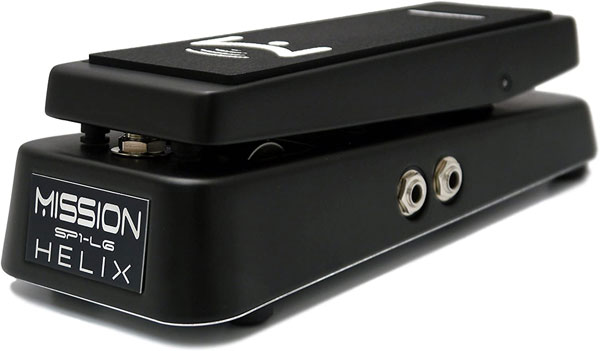
| Estimated Price | $150 |
| Type | Analog |
| Effects | Volume |
| Connectivity | 1 x 6.35mm Jack Input, 1 x Output |
| Power | 9 Volts DC |
My Review: Designed to work best with Line-6’s Helix amplifier, but equally effective as an expression of the volume pedal, the Helix by Mission Engineering features several useful abilities. I was impressed by the fact that you can use it to activate effects by pressing down on the footswitch, making it the perfect companion for multi-effects processors.
Alternatively, I found that you can simply use the Helix to control the volume of your guitar. It soon became apparent that this device is built using high-quality components, which include an all-metal chassis and a non-slip rubber surface for maintaining complete control over the pedal’s position.
If you do happen to own a Line 6 Helix amplifier, then you can use this pedal to control all of the onboard effects. The toggle feature was great, as it allowed me to switch between presets instantly, by simply clicking down on the footswitch. I’d summarize that this makes for convenient hands-free operation of multiple effects simultaneously.
The extensive connectivity options of the SPL-1-L6 make it worthy of consideration. Although it’s predominantly for use with the Helix amp, it has many different uses that make it suitable for a range of dynamic-based applications.
Who is this best suited for: The Mission Engineering Helix pedal is perfectly suited to guitarists who require both a volume controller and a method of managing their various other effects pedals. It is built from high-quality materials, making it a good choice for musicians who are likely to use it constantly for recording, live shows, or rehearsals.
Bottom Line: Boasting excellent durability, easy operation, and multiple functions, the Mission Engineering Helix pedal is a reliable volume and expression controller. Whether you need to use it simply as a standalone volume pedal, or to activate effects on your amplifier, this pedal has the necessary capabilities to perform both roles to a high standard.
14. Fender EXP-1
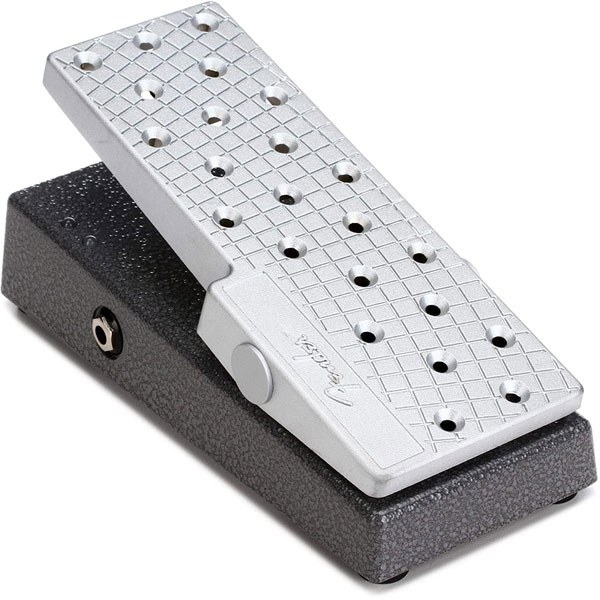
| Estimated Price | $90 |
| Type | Digital |
| Effects | Volume |
| Connectivity | 1 x 6.35mm Jack Input, 1 x Output |
| Power | 9 Volts DC |
My Review: Although Fender is best known for their extensive range of high-end instruments and amplifiers, I think one of the best-kept secrets in the industry is that they also produce a selection of respectable pedals. The EXP-1 is their flagship volume and expression pedal, so I was particularly eager to test it out.
Offering dual-mode operation, I was impressed to find that the EXP-1 uses digital technology to control the volume of an instrument or to change the way it interacts with other effects. This opened the door for me to switch between the volume and expression modes by pressing the toe-end of the pedal. The mode that is selected is indicated by red and green LEDs, which took me a little getting used to, but once I became accustomed to the feature, using it became a breeze.
The EXP-1 works best when it is paired with the Mustang II, IV, and V amplifiers, or on the Mustang Floor multi-effects unit. If you own one of these devices, in my opinion, there’s no better volume pedal on the market for controlling them.
Who is this best suited for: If you’re intending on purchasing an expression pedal in addition to a volume pedal, the EXP-1 by Fender allows you to combine the two. It’s ideal for guitarists who use an array of effects, as it allows you to directly control both the volume level and the individual parameters of other pedals.
Bottom Line: Volume and expression pedals perform different functions, but operate similarly. That’s why the Fender EXP-1 is such a useful tool for a musician – it allows you to instantly switch between volume and expression. As you’d expect with a Fender product, it’s built using high-quality components and operates very smoothly.
15. Ernie Ball Black VP jr
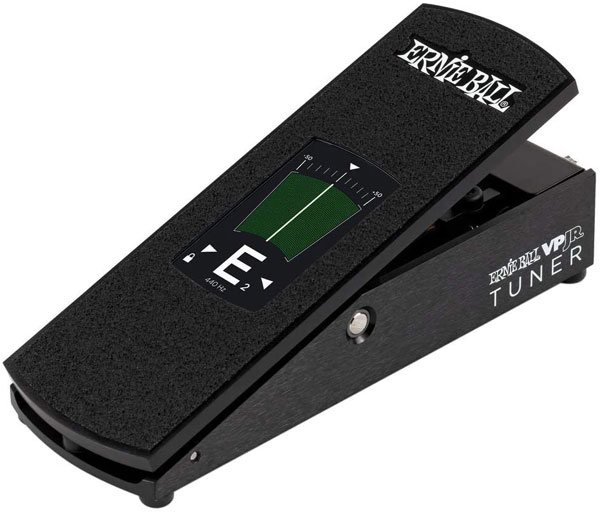
| Estimated Price | $200 |
| Type | Digital |
| Effects | Volume |
| Connectivity | 2 x 6.35mm Jack Input, 2 x Output |
| Power | 9 Volts DC |
My Review: The Ernie Ball VP Jr Black edition is a reincarnation of the popular VP Jr Standard, with several additional performance-boosting capabilities and features. Firstly, the pedal has an onboard tuner, which makes it stand out amongst other standard volume pedals.
Compared to the VP Jr Standard, which is one of my personal favorite volume pedals, the notable difference is that this special edition has a more refined and distinguished appearance.
The onboard chromatic tuner provided me with fast and accurate tuning. When I switched back to volume mode, the screen displays a graphic volume monitor so that I was able to oversee the exact status of my dynamics.
The screen is touch-operated, which I found added a modern element to the pedal. It is built from highly robust materials, and I was impressed with the way that the rocker plate performs both smoothly and efficiently, holding its position when not in use so that I could concentrate on other aspects of the performance. Also, the all-black design gives this pedal an aura of elegance.
Who is this best suited for: If you’re looking for a tuner pedal in addition to a volume controller, the Ernie Ball VP Jr Black edition is an ideal choice. It allows you to view the status of your instrument’s tuning and provides a graphic indication of the volume levels you have set.
Bottom Line: A truly unique offering, the Ernie Ball VP Jr Black edition performs reliably and includes several modern features. The addition of a display screen is highly useful, as it allows you to keep tabs on the various settings of the pedal. The footplate is responsive but provides enough resistance to hold its position when not in use.
16. BOSS FV-500L
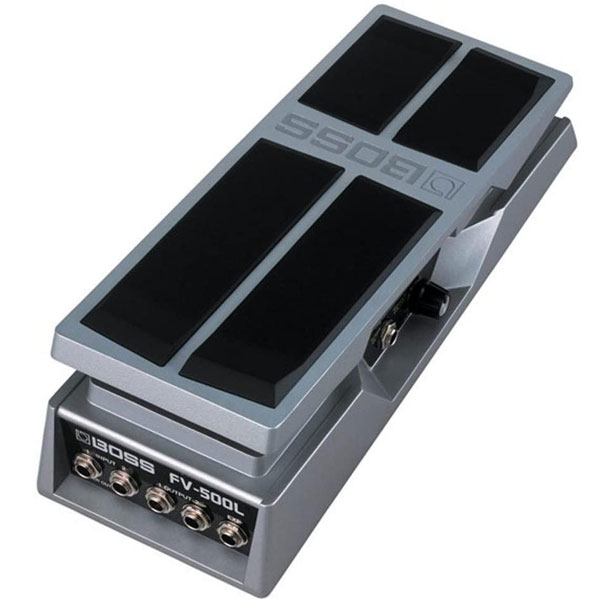
| Estimated Price | $120 |
| Type | Analog |
| Effects | Volume |
| Connectivity | 2 x 6.35mm Jack Input, 2 x Output |
| Power | 9 Volt DC |
My Review: Boss’ range of industrial-strength volume pedals continues with the low impedance FV-500L. Building upon the success of their FV-300 series, the manufacturer has improved the performance of the pedal by installing high-quality inner circuitry. The additional connectivity option was what I noticed at first, as this pedal was much more extensive compared to many others in the FV-300 series that I’d seen in the past.
The FV-500L operates completely noise-free, even when it is used to raise the level of a guitar, bass, or keyboard. It is housed in a heavy-duty aluminum die-cast chassis, and the pedal is coated in rubber to ensure maximum grip and traction at all times.
After testing the FV-500L, it was easy for us to identify the qualities that set it apart from similarly priced devices. Due to the experience BOSS gained through over ten years of producing devices in their FV300 range, they have been able to improve the smooth motion of the rocker plate in this pedal, which makes it perfect for accurately tweaking the volume of a guitar or bass.
Who is this best suited for: The Boss FV-500L is built for low-impedance pedals, so it’s well suited to guitarists and bassists of all styles. Due to its road-ready durable built, it is also a great option for musicians who are likely to use it regularly.
Bottom Line: With the classic Boss durability and specific circuitry suited to low-impedance devices, the FV-500L is a very capable volume pedal indeed. It features an adjustable torque that allows you to set the tension of the pedal to suit your preferences and also doubles up as an expression pedal when required.
17. Line 6 EX-1
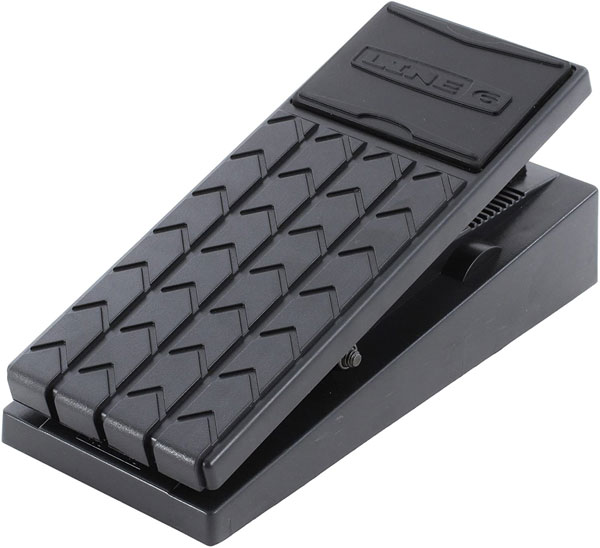
| Estimated Price | $60 |
| Type | Analog |
| Effects | Volume |
| Connectivity | 1 x 6.35mm Jack Input, 1 x Output |
| Power | 9 Volts DC |
My Review: I can safely say that the EX-1 by Line 6 is a multi-faceted pedal. It includes two presets, which I found to be very useful when the pedal is being used for expression or to control other external effects on my pedalboard. These include pitch control, which is great as it acts like a whammy pedal, and custom wah are ideal for creating filter effects.
Or, I noticed that you can simply use the EX-1 as a standard volume pedal. For this purpose, I found out that it performs adequately, and I put this down to the responsive rocker plate mechanism and smooth operation. The inclusion of a rubber grip-coating on the pedal improves its usability even further.
The inclusion of two distinctive settings instantly raises the EX-1 above many of its competitors. It’s ideal for situations where you may be using multiple high-gain pedals, and need to keep the sharp increases in volume to a minimum.
Who is this best suited for: If you want to combine a volume pedal with an expression of controlling external effects, the Line 5 EX1 is a worthy choice. Thanks to its durable construction, it is also well suited to touring musicians.
Bottom Line: The EX-1 by Line 6 offers two useful effects presets. Firstly, there’s the pitch control mode, which gives you complete control over the pitch of your guitar. Then there’s the custom wah, which adds a layer of filtering to your output. Or, you can simply use the pedal as a standard volume controller.
The Ultimate Volume Pedal Guide
As a musician, it’s very easy to become mesmerized by effects pedals that have extreme tone-altering capabilities. Indeed, it’s a lot of fun transforming your tone and sculpting your sound using a variety of processing tools.
However, some pedals are equally as vital to your overall tone, but often get overlooked because their role is more understated. Volume pedals fall into this category. When used effectively, one could argue that a volume pedal is just as important to your sound on the whole, like any other pedal.
In the remainder of this ultimate guide to volume pedals, we’ll take a detailed look at all of the various uses, capabilities, and benefits of these underappreciated devices. Whether you’re an experienced effect pedal enthusiast or a complete novice, you’ll find the information useful and beneficial to your search for the ideal volume pedal.
The Purpose of a Volume Pedal
As the name suggests, volume pedals are tools for controlling the level of an instrument’s output. They are often employed by musicians to allow them to have complete dominion over their dynamics, and ensure that it remains consistent.
These pedals can be used for a variety of purposes, depending on where you choose to position them in your signal path. We’ll get into that in detail later in this guide. Some musicians choose to use multiple volume pedals interspersed at different points in their signal chain, as this allows them to control the individual dynamics or certain effects groups, such as distortion, modulation, or timing-based effects.
Although all volume pedals intend to perform the same basic function, there’s plenty of variation from model to model. High-end volume pedals are likely to offer various controls that will provide you with more freedom, while more primitive versions simply control the dynamics without any additional options included.
Choosing the perfect volume pedal requires you to establish exactly what you intend to use it for. Do you simply need a pedal to control the overall dynamics of your rig, or are you also interested in creating swells and fade-outs?
Volume Pedals vs. Expression Pedals
Volume pedals are often grouped with expression pedals, and although the two do operate similarly to an extent, there are noticeable differences that should be considered. A volume pedal, as the name suggests, is simply designed to provide a musician with control over the dynamic output of their instrument.
Expression pedals, on the other hand, are used to alter certain controls on other effects pedals without needing to bend down and use their hands. This is convenient if the musician often changes the various parameters on their pedals during a performance, as they can use multiple expression pedals to control their whole signal chain.
Let’s use delay pedals as an example to compare the functions of volume and expression pedals. Firstly, a volume pedal would simply allow you to adjust the dynamics produced by the delay pedal, with no alterations to the actual characteristics of the effect. Conversely, an expression pedal would allow you to alter the decay, feedback, and timing of the delay.
Some volume pedals double up as expression pedals. This means you can choose which way you want to use them, depending on the method of connectivity. Guitarists who have extensive signal chains are likely to use multiple volumes and expression pedals which are specifically positioned to alter the output of certain effects.
Combining Volume Pedals with Other Effects
One of the most useful things about volume pedals is that due to their unobtrusive nature, they are highly compatible with a range of other effects. One could argue that a volume pedal works most effectively when it is used to control not only the dynamics of the guitar but also the dynamics of other effects within a signal path.
Gain-based effects like overdrive, distortion, and fuzz benefit greatly from a volume pedal controlling their dynamics. Due to the slightly unpredictable dynamic tendencies of any effects which add gain to your signal, it can be difficult to strike a consistent balance. Using a volume pedal allows you to quickly raise or lower the dynamics of these pedals, providing maximum control in real-time.
Likewise, modulation-based pedals are also slightly unpredictable. Chorus, phasers, flangers, and octave pedals all cause noticeable alterations to your dynamics, so using a volume pedal to tame them or provide them with a necessary boost is highly useful.
When paired with reverbs and delays, volume pedals prove their worth. Both of these effects cause there to be decay, or tail, to the original sound. Depending on the settings of the reverb and delay pedal, the amount of time that the decay lasts varies. Using a volume pedal to control the dynamics of these effects allows you to create fade-ins and fade-outs, which are great for ambient, textural styles of playing.
Even if you don’t have a plethora of other effects pedals at your disposal, a volume pedal is still equally as useful for controlling the dynamics of your clean tone. You can use it to gradually increase or decrease the volume, which in itself can be used as an effective processing tool both onstage or in your recordings.
Volume Pedals in the Record Studio
Volume pedals are invaluable tools for playing live, but they also offer numerous benefits in the recording process. Other effects pedals indeed have a more transformative impact on your tone, but volume pedals provide you with maximum control over your dynamics when recording. This makes it easier for you to be intentional with the volume of your instrument without having to rely on mixing.
When recording with a volume pedal, you essentially have two options – you can either send your output into an amplifier and place a microphone in front of the speaker to capture the output, or you can send the output into a direct input on an audio interface, preamp, or mixer. Both methods offer contrasting results.
The advantage of using the amplifier method is that you can create consistency between your recorded tone, and that of your live performances, provided you use the same amplifier for both purposes. However, a variable factor is a microphone you choose to employ for recording the amplified output This, coupled with the choice of the amplifier will impact the coloration of your tone.
If you choose to use a direct input rather than an amplifier, your tone is likely to be cleaner, and consequently easier to mix. The quality of the interface, mixer, or preamp that you send your output into will also impact the overall tone that is captured. One advantage of this method is that if you decide that you would rather use an amplifier after recording directly into an interface, you can simply re-amp the signal.
Once you’ve used your volume pedal to record through an amplifier, there’s no way to “clean up” the signal. You are forced to work with whatever sound the amplifier produces, or re-record the take using an interface or mixer. For home-studio setups where it is perhaps not viable to use an amplifier due to space restrictions or limits on the noise you can make, interfaces provide the perfect solution.
True Bypass & Buffered Volume Pedals
Although modern effects pedals are mostly capable of noiseless operation, this wasn’t always the case. When manufacturers first began to produce them, guitarists had to contend with electronic hums and buzzes, especially when using multiple pedals in a signal chain. This was due to the inner circuitry of the pedals.
True bypass and buffered circuitry are the two main methods developed by guitar effects technicians to combat the issue of a noisy signal. The majority of pedals that are produced today use one of these two innovative circuitry designs to keep your signal path as clean and reliable as possible. Although they do achieve a similar result both methods are vastly contrasting in their means of doing so.
True bypass volume pedals permit the signal of an instrument to freely flow through a pedal when it is not activated. To simplify, this means that the complete tone and frequency output of the instrument is preserved, with no additional coloration provided by the pedal. True bypass doesn’t boost the signal in any way, and therefore, the only downside to this method is that when you use extensive cable runs (over 18.5ft) you suffer tonal degradation.
Buffered volume pedals differ from their true bypass counterparts in that they do increase the strength of the instrument’s signal. Once the signal has been boosted, the pedals drive it through the chain, which reestablished the original tone and dynamics. Regardless of whether a pedal is switched on or off, the buffering process is constantly taking place.
So how do you know which type of volume pedal is best suited to your signal chain? Generally, this can be decided based on the length of your cable run. As I mentioned in the previous paragraphs, true bypass pedals lose their effectiveness when your signal chain is made up of over 18.5 ft of cables. For anything less that than, they are an ideal choice and will perform adequately.
When you venture into the territory of having cable runs that exceed 18.5ft, buffered pedals are the most reliable option. Their ability to consistently keep your instrument’s output at a certain dynamic level, and protect its tonal integrity even when extensive cable runs are being used, make them a popular choice for guitarists who have particularly crowded pedalboards.
There’s no harm in mixing up true bypass pedals with buffered pedals, so don’t worry if the particular volume pedal that you choose doesn’t line up with your other effects in that respect. Indeed, using a combination of these two pedal types is a safer bet than simply relying on one variety. If you do choose to mix the two, it’s best to start your signal path with a buffered pedal, as this will strengthen your instrument’s tone before it reaches the other pedals.
Positioning a Volume Pedal in Your Signal Chain
Once you’ve amassed a collection of effects pedals, the most important decision you’ll make in terms of the impact on your tone is how you choose to position them in a signal chain. This is a constant topic of debate amongst musicians, with some preferring to stick to the advised orders, while others use experimental positioning to achieve unique and individual tones.
Let me start by saying that there is no “right or wrong” way to position your pedals in a signal chain. Some of the most innovative guitarists and bassists have created their signature tones by doing things in a way that conventional wisdom would regard as being “wrong”. With that being said, some general guidelines can be used to create the intended effects from your pedals.
The interesting thing about volume pedals, in particular, is that they can be positioned in one of three locations in your signal chain, depending on the way you want them to perform. Generally, the order of a signal chain would loosely resemble the following: firstly, you have your tuner, which is then sent into any filter pedals such as wah-wah or low-pass filters.
Next, you have compressors, limiters, and EQ pedals, which are subsequently followed by gain-based effects such as distortion, overdrive, or fuzz. After you’ve added your dirt, then comes modulation-based pedals. These include octave or pitch-shifter pedals, phasers, chorus, flangers, and tremolo, and so on. After modulation, you finish off the signal chain with delays and reverbs, and then send the signal out into the amplifier.
Within this conventional ordering of your effects pedals, a volume pedal can be slotted in either at the very beginning, middle, or end of your signal chain. Each of these three positions offers various benefits, but they also have their drawbacks. It’s advisable to try them out and see which works best for your setup.
Positioning the volume pedal at the beginning of your signal chain will cause it to work in the same way the volume control on your guitar or bass does. It will clean up your signal, minimizing any coloration caused by an amplifier, but it won’t have any means of affecting the volume of the pedals that follow it.
Alternatively, positioning the volume pedal in the middle of your signal chain will allow you to keep your output more consistent. A popular method is to place the volume pedal just after your distortion, overdrive or fuzz, and before any reverbs or delays. This ensures that the amount of drive is kept consistent, and when you use the volume pedal to raise your dynamics, you can control how much is fed into your reverbs and delays.
Finally, if you want to use the pedal as a master volume control, then you will need to position it at the very end of your signal chain. Doing so will mean that every single pedal in your chain is affected when you use the volume pedal to alter your dynamics. The advantage of this is that you can completely mute all of your pedals simply by turning down the volume pedal. You can also use it to gradually fade out your signal, and create swells, which are gradually build-ups of dynamics.
Positioning your pedals in a signal chain is, to an extent, a subjective matter. Therefore, I’d encourage you to experiment with both the conventional methods presented here and more unorthodox orderings. Whatever order you use will produce noticeably different results, and you might just stumble across a certain tone that becomes your signature sound.
Multiple Output Volume Pedals
On your search for volume pedals, you might have become aware that rather than offering the standard single-input single-output, some of them have dual outputs installed. This is more common on stompbox-style effects, but on some high-end volume pedals, manufacturers tend to install two outputs rather than one.
Having a pair of outputs creates the possibility of using two amplifiers. But why exactly would that be beneficial? Well, for starters, having two amplifiers allows you to separate your dry signal from your effects chain. This means that you can take one output from a volume pedal, or any other pedal with dual outputs for that matter, and send it into a “clean” amplifier. The other output is then sent into another amplifier which is dedicated to only playing your effects pedals.
This achieves a fuller, more consistent level of dynamics. When you are playing your guitar, bass, or keyboard completely clean, the first amplifier will be active. Then, as soon as you use an effects pedal that comes after your dual-output pedal, the second amplifier exclusively projects the processed signal, resulting in a kind of double-tracking effect, which creates the illusion that two instruments are playing simultaneously.
This method of using dual outputs with a volume pedal or other effects pedal is sometimes referred to as “signal splitting”. It’s commonly used by guitar players in bands where there is no second guitarist to thicken the sound. If, for example, they are transitioning from a chord-based rhythm guitar section to a single-note melody or solo, they can activate their effects pedals and retain their clean signal in the background, thus preserving the power of their instrument’s output.
The technique of signal splitting is also commonly used by bassists who utilize effects pedals heavily in their performance. Bass guitar requires the retention and consistency of low-end frequencies, and sometimes activating a distortion or other effects pedal can cause the original thickness-of-tone to be significantly compromised.
Thankfully, using a pedal with dual outputs provides the perfect solution. When the bassist turns on their effects, it plays through a second amplifier while their original, clean low-end still drives their overall tone, and there is no loss of power caused by the process.
Passive vs. Active Volume Pedals
One of the main things to be aware of when looking for a volume pedal is that there are two distinctive types: passive and active. These categories refer to the electronic circuitry of the volume pedal, which subsequently has a significant impact on their performance and whether they are suitable for your requirements.
Passive volume pedals tend to be a little less expensive than active models. They essentially perform the same function as the volume potentiometer on your guitar, except they are used hands-free, on the floor. Compared to active volume pedals, passive models feel and perform completely differently. The sound of the sweep they produce is different, as is the location of the “sweet spot”. The advantage of passive volume pedals is that they don’t require external power because there is no circuitry inside.
Active volume pedals are seen as the better option, particularly for musicians who require a good level of control over their dynamics. Although they are generally more expensive than passive offerings, this is reflected in their quality.
All active volume pedals include a buffer within their circuitry, which is a device used to maintain the integrity and constancy of the signal. They do require external power due to the buffered circuitry, but this can easily be provided. The main pro of active volume pedals is that they prevent tonal degradation and signal loss.
Compression, EQ & Volume Pedals
Like volume pedals, compressors and EQs fall into the same category of dynamic-altering effects. Each of these three pedals performs a vital function in determining how your guitar, bass, or keyboard responds to the velocity of your playing.
Compressors are used to create dynamic consistency. They operate based on a threshold, which can be altered. The threshold determines the level at which the compressor kicks into action. It then either raises the signal to a certain level or limits it in the same way.
EQ is responsible for editing the frequency output of a sound. The frequencies are usually split into groups or bands as they are commonly called. You can then adjust the prominence of each frequency band, adding more bass, mids, or treble.
Volume pedals work very well with both compressors and EQ pedals. Depending on where you choose to position them concerning the other pedals, they will have a varying effect. Starting your signal chain with volume, compression, and EQ pedals is a great way to retain maximum control over the dynamic output of your instrument and set the foundations upon which the rest of your effects pedals can go to work.
Multi-Effects Volume Pedals
Some volume and expression pedals are included as part of a multi-effects unit. These are great acquisitions if you intend to stack your pedalboard with a variety of effects in addition to your volume pedal, but would rather do so in a space-effect way.
The only downside to multi-effects pedals is that rather than focus solely on one single effect, the manufacturers have to spread their attention across several. In some cases, this is reflected in the individual quality of each effect. Volume pedals that are linked to other effects are useful because you can them to control the effects that are housed on the same pedal without needing to create a signal chain, as you would with individual pedals.
Creating Swells with Volume Pedals
One of the most interesting results that can be achieved using volume pedals, is creating swells. This is a result of limiting the initial attack of a note or chord, then gradually adding more volume until the sound reaches a peak. It’s a technique often used in electronic music, but can also be highly effective as a textural solution for guitarists.
Creating swells requires a little practice. You have to be able to gauge exactly when the right time is to gradually increase the volume because if you do this too quickly it will cause a sudden spike and the build-up will be compromised.
Swells are especially effective when you are using a volume pedal in conjunction with other effects. Reverb and delay are two of the most popular effects of creating swells. This is because they both can increase the tail end of a note, and decay it so that it lasts for much longer.
When you combine a volume pedal with delay or reverb, you can use it to deliberately fade-in the tail-end of the note, therefore creating a gradual increase in volume and the “swelling” sound. It’s a great way to start or end performance or to add ambient textures to a song.
Experimenting with different techniques and pedal combinations is necessary to learn how to swell properly. The great thing about this effect is that you can use it in any way you see fit, and as you become more aware of the different ways to alter how the swell sounds, you will have more tools at your disposal.
Using Volume Pedals with Other Instruments
In addition to guitars, volume pedals also make useful companions for basses, keyboards, synthesizers, and electronic devices like drum machines. This is one of the main reasons that a volume pedal is a wise investment because you can use it for so many different purposes.
Using a volume pedal with bass works in the same way as it does with a guitar. It’s less common for bassists to use volume pedals though, perhaps because generally the low-end needs to be consistent, whereas a guitar is usually used with more variation in that respect.
Keyboards and synthesizers benefit greatly from being paired with a volume pedal, most because it’s difficult to adjust the onboard volume controls with your hands whilst playing a keyboard. Having a hands-free option that can be used while you are playing makes things much easier.
If you’re using a drum machine, you can use a volume pedal to gradually increase or decrease the level of the percussion. For recreating studio fade-ins in a live setting, pairing these two devices is by far the easiest way, other than using automation on a laptop or mixer.
Power Requirements
Most volume pedals require 9v DC to operate effectively. In some cases, the pedal might need more voltage due to additional digital features, or if it houses multiple effects. In this instance, the pedal will likely require 12v or in some very rare cases 18v DC.
The most efficient and convenient method for powering volume pedals, and all other pedals for that matter, is by using a dedicated power supply. These devices have specific outputs that provide the necessary voltage for the pedal. Power supplies come in a variety of forms, some with more capabilities than others.
The main advantage of using a power supply with your volume pedal is that you can mount it to your pedalboard and not have to go through the rigmarole of setting up the individual power supplies to each effects pedal. You can simply leave the pedals plugged into their respective outputs so that your pedalboard is ready to operate right away.
Although it’s rarer in volume pedals than smaller stompboxes, some can be powered by 9v batteries. This provides you with a convenient alternative to using a power supply, but it’s not as reliable due to the chance that the battery will go flat midway through a performance.
For that reason, it’s best to combine the use of batteries and a power supply whenever possible. That way, if either of the two power sources experiences any issues, the other is there to take up the mantle, and ensure that you’re output doesn’t suddenly cut out midway through a live performance or recording session.
Final Thoughts:
Whether you’re a guitarist, bassist, keyboardist, or multi-instrumentalist, having complete control over your dynamics is essential if you want to be precise with your performances. Volume pedals are amongst the most versatile pedals you can purchase.
Hopefully, after reading this comprehensive guide, you’ve now got all of the necessary information required to choose the ideal volume pedal featured at the beginning of this post. Whichever you choose, I’m sure that the newfound control over your instrument’s dynamics will be very beneficial.

My name is Chris and I’ve had a passion for music and guitars for as long as I can remember. I started this website with some of my friends who are musicians, music teachers, gear heads, and music enthusiasts so we could provide high-quality guitar and music-related content.
I’ve been playing guitar since I was 13 years old and am an avid collector. Amps, pedals, guitars, bass, drums, microphones, studio, and recording gear, I love it all.
I was born and raised in Western Pennsylvania. My background is in Electrical Engineering, earning a Bachelor’s degree from Youngstown State University. With my engineering experience, I’ve developed as a designer of guitar amplifiers and effects. A true passion of mine, I’ve designed, built, and repaired a wide range of guitar amps and electronics. Here at the Guitar Lobby, our aim is to share our passion for Music and gear with the rest of the music community.
